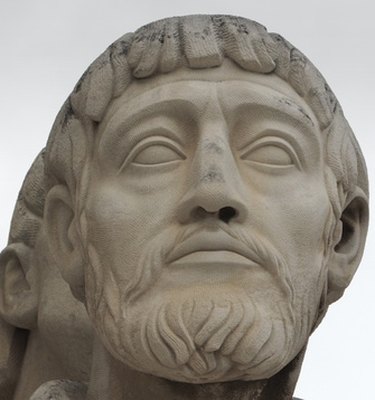Things You'll Need
Portland cement
5-gallon bucket
Paper fiber insulation
Paper strips
Fibermesh
Latex additive for concrete
Joint compound
Water
Wire
PVC
Metal rods
Clay modeling tools
Sandpaper
Steel wool
Rotary tool with cutting and grinding attachments
Concrete sealant

White cement, or portland cement, is a highly refined limestone powder used as a base to create mortar or concrete. When combined with water and a binder and then allowed to dry, portland cement becomes very hard. You can mold white cement like clay while it's wet or carve it like stone after it dries. By experimenting with the content and moisture levels of the white cement base, you can make a variety of sculptures.
Cement Sculpting Mixture
Step 1
Put on a mask and protective gloves.
Video of the Day
Step 2
Add white portland cement with binder in a 1:1 ratio in a 5-gallon bucket. Use paper fiber insulation as binder, paper strips or fibermesh, a product designed specifically for use with concrete to provide strength and prevent cracking. Artists' preferences vary, so experiment.
Step 3
Add a concrete latex or joint compound and water in a 1:4 ratio; the latex helps to give the mixture a smooth, clay-like consistency.
Step 4
Mix with your hands until the cement sculpting base reaches the consistency of modeling clay.
Creating the Sculture
Step 1
Construct the armature for the sculpture. Use wire, PVC or metal rods; do not use wood as it will absorb the moisture from the cement and rot, causing the structure to fail at a later date. When constructing the armature, build the dimensions to accommodate the thickness of the cement.
Step 2
Add the white cement sculpting base to the armature. Start at the base of the sculpture and build upward. If the cement does not adhere to the armature or slumps, the water content is too high. Add more binder from until the cement remains firm but workable.
Step 3
Shape the cement while wet. The wet cement sculpting base will mold like clay. Use the same tools you would use to work with modeling clay.
Step 4
Wrap the cement sculpture in plastic to help retain moisture when you are not working. Depending on the moisture content of the cement sculpting mixture, the sculpture may retain its pliability for two or three days.
Step 5
Shape and polish the statue after the cement sculpting base begins to dry. Use sandpaper, steel wool, rotary cutting and grinding tools or other stone-carving tools to smooth the cement and create fine details.
Step 6
Allow the cement to cure for three days to a week, depending on the total moisture content of the cement base. The longer you allow the cement to cure, the better.
Step 7
Use a concrete sealant to cover the cement sculpture to prevent the sculpture from cracking due to changes in temperature or humidity over its lifetime. If you plan to display the sculpture outdoors, this step is imperative.
Warning
Wear protective gloves when working with wet cement. Prolonged skin exposure to portland cement mixtures can cause cracking and burning. Always wear a mask when mixing portland cement and when sanding or carving cement.
Video of the Day
- Portland Cement Association: How Is White Cement Different and Why is it Used in Decorative Concrete?
- Art Concrete: Concrete Art: FAQs
- Sculptures by Jonathan R. Loppnow: Cement and Paper Fiber Sculpting
- C. S. Snider Designs: Sculpture Process
- Propex Concrete Solutions: Residential Slabs
- Concrete Network: Use Fibers for Secondary Reinforcement
- Sculptor.org: Concrete Sculptors and Sculpture